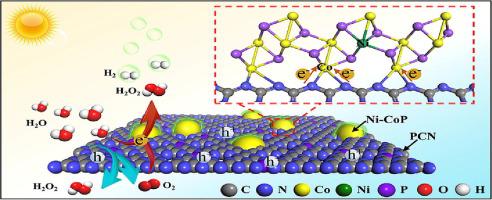Chemical Engineering Journal ( IF 13.3 ) Pub Date : 2023-07-20 , DOI: 10.1016/j.cej.2023.144898 Linwen Zhang , Weichao Dong , Yajing Zhang , Xiangju Song , Heqing Jiang

|
Photocatalytic water splitting into hydrogen (H2) fuel or hydrogen peroxide (H2O2) chemicals has been considered as an ideal approach for converting solar energy into chemical energy. However, simultaneous production for these two valuable chemicals was always accompanied by the unsatisfactory catalytic productivity. Herein, we have employed the absorption-phosphidation strategy for precisely anchoring Ni-doped cobalt phosphide (CoP) nanoparticles (∼4 nm) on phosphatized carbon nitride (PCN) nanosheet. Without adding any sacrificial reagents, the photocatalyst exhibited excellent H2 evolution activities (248 μmol·g−1) and H2O2 generation (894 μmol·g−1) at 2 h, one of the highest activities among the previously reported carbon nitride-based catalysts. Comprehensive characterizations revealed that atomic-scale doped Ni element within CoP nanoparticles significantly accelerated surface catalytic reaction kinetics, which serve as the active centers for H2 and H2O2 evolution through reduction reaction. The PCN nanosheets with the increased electric conductivity and the decreased band gap energy could effectively promote photo-generated charge separation and transfer. Moreover, the Co-N coordination effect between PCN and Ni-doped CoP cocatalysts, could also accelerate the interfacial electron transfer. Synergizing the PCN nanosheet and intimately anchored Ni-CoP nanoparticles remarkably promoted the photocatalytic productivity and stability for simultaneous H2 and H2O2 production.
中文翻译:

将镍掺杂的磷化钴纳米粒子精确锚定在磷化氮化碳上,以实现高效的光催化水分解
光催化水分解成氢气(H 2)燃料或过氧化氢(H 2 O 2)化学品被认为是将太阳能转化为化学能的理想方法。然而,同时生产这两种有价值的化学品总是伴随着不令人满意的催化生产率。在这里,我们采用吸收磷化策略将镍掺杂的磷化钴(CoP)纳米颗粒(~4 nm)精确锚定在磷化氮化碳(PCN)纳米片上。在不添加任何牺牲试剂的情况下,该光催化剂表现出优异的H 2析出活性(248 μmol·g -1)和H 2 O 2生成活性(894 μmol·g-1)在2小时内,这是先前报道的氮化碳基催化剂中最高活性之一。综合表征表明,CoP纳米颗粒中原子级掺杂的Ni元素显着加速了表面催化反应动力学,作为H 2和H 2 O 2的活性中心通过还原反应进行演化。PCN纳米片具有增加的电导率和降低的带隙能量,可以有效促进光生电荷的分离和转移。此外,PCN和Ni掺杂CoP助催化剂之间的Co-N配位效应也可以加速界面电子转移。PCN 纳米片和紧密锚定的 Ni-CoP 纳米颗粒的协同作用显着提高了同时生产 H2 和 H2O2 的光催化生产率和稳定性。


















































 京公网安备 11010802027423号
京公网安备 11010802027423号